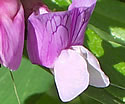Lathyrus palustris (Marsh Vetchling)
| Also known as: | Marsh Pea, Wild Pea |
|---|---|
| Genus: | Lathyrus |
| Family: | Fabaceae (Pea) |
| Life cycle: | perennial |
| Origin: | native |
| Habitat: | part shade, sun; wet meadows, shores, swamps |
| Bloom season: | June - July |
| Plant height: | 1 to 4 foot vine |
| Wetland Indicator Status: | GP: FACW MW: FACW NCNE: FACW |
| MN county distribution (click map to enlarge): |  |
| National distribution (click map to enlarge): |  |
Pick an image for a larger view. See the glossary for icon descriptions.
Detailed Information
Flower: 

![[photo of flowers]](/udata/r9ndp23q/pd/lathyrus-palustris-10-21-t.jpg) Clusters of 2 to 6 stalked flowers on long naked stems that arise from the leaf axils. Individual flowers are ¾ inch long and a typical shape for a member of the pea family. Flower color varies from deep pink to purple to blue. A 2-tone purple and white or purple and blue flower is not unusual. The calyx holding the flower is bell-shaped with irregular teeth around the tip, longer teeth on the underside about the same length as the tube. The cluster's stem is typically as long as or longer than the compound leaf stem.
Clusters of 2 to 6 stalked flowers on long naked stems that arise from the leaf axils. Individual flowers are ¾ inch long and a typical shape for a member of the pea family. Flower color varies from deep pink to purple to blue. A 2-tone purple and white or purple and blue flower is not unusual. The calyx holding the flower is bell-shaped with irregular teeth around the tip, longer teeth on the underside about the same length as the tube. The cluster's stem is typically as long as or longer than the compound leaf stem.
Leaves and stem: 

![[photo of leaves]](/udata/r9ndp23q/pd/lathyrus-palustris-10-9-t.jpg) Leaves are compound in 2 to 4 pairs; attachment is alternate with the leaflets attached oppositely. Each leaflet is generally elliptical, up to 2½ inches long and ½ inch wide, though they can range from short and wide to long and narrow, tapering to a point at both ends. There is a tendril at the end of the leaf stem that entwines around other plants.
Leaves are compound in 2 to 4 pairs; attachment is alternate with the leaflets attached oppositely. Each leaflet is generally elliptical, up to 2½ inches long and ½ inch wide, though they can range from short and wide to long and narrow, tapering to a point at both ends. There is a tendril at the end of the leaf stem that entwines around other plants.
![[photo of stipules]](/udata/r9ndp23q/purple/marsh-vetchling_0609_180035-t.jpg) The pair of leafy appendages (stipules) attached to the stem at the leaf joint are small and narrow, pointed at both ends with the upper portion nearly twice as long as the lower, in outline shaped like half of an arrowhead. Stems are usually, but not always, “winged”, making it look and feel ribbon-like. Stems and leaves may be hairless or hairy to varying degrees, and often tangles itself in the surrounding vegetation.
The pair of leafy appendages (stipules) attached to the stem at the leaf joint are small and narrow, pointed at both ends with the upper portion nearly twice as long as the lower, in outline shaped like half of an arrowhead. Stems are usually, but not always, “winged”, making it look and feel ribbon-like. Stems and leaves may be hairless or hairy to varying degrees, and often tangles itself in the surrounding vegetation.
Notes:
There are 4 varieties of Lathyrus palustris but it is not clear where the ranges are for each, nor does the DNR or Bell Herbarium make any distinctions at this time. According to Gleason and Cronquist's Manual of Vascular Plants, they should all be represented somewhere in Minnesota. Marsh Vetchling is very similar to Veiny Pea (Lathyrus venosus), which has distinctly angled and wingless stems, 4 to 8 pairs of leaflets, more flowers per cluster, and prefers drier habitats.
Native Plant Nurseries, Restoration and Landscaping Services ↓
More photos
 2-tone flowers more flowers
2-tone flowers more flowers
 a tangle of Marsh Vetchling
a tangle of Marsh Vetchling
Photos by K. Chayka taken at Long Lake Regional Park, New Brighton, Ramsey County. Other photos courtesy Peter M. Dziuk.
Comments
Have you seen this plant in Minnesota, or have any other comments about it?
on: 2009-06-16 10:03:24
Some of the pink vetchling is growing along the bike path in Deephaven, near Minnetonka Boulevard, next to some blooming birdsfoot trefoil...a nice color combo
on: 2014-07-01 17:48:20
We live across from the Sherburne National Wildlife Refuge. Wild Pea or vetchling is quite abundant this year. Maybe because of all the rain we have had.
on: 2017-06-12 12:23:01
Drainage ditch growing along side yellow lady's slippers.






